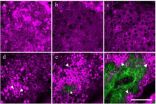(Press-News.org) More than two hundred gene locations have now been identified for the chronic bowel condition Crohn's Disease, in a study that analysed the entire human genome.
Published today in The American Journal of Human Genetics, scientists at UCL have devised a new method for identifying and mapping gene locations for complex inherited diseases. Using this method, they have been able to identify a large number of additional genes for Crohn's Disease, making a total of more than 200, which is more than have been found for any other disease. For example, there are just 66 known gene-regions for type 2 diabetes.
Crohn's Disease, a type of Inflammatory Bowel Disease, is a chronic illness of complex origins affecting approximately 100 to 150 people per 100,000. Understanding the genetic component of such complex diseases is central to explaining patients' symptoms and improving treatment.
Despite Crohn's having a large genetic component, this has been hard to dissect. This is partly due to the large number of genes involved, their complex interactions with environment and the spectrum of clinical presentations. As a result, many scientists have been focusing on ever larger cohorts of patients under the impression that larger data sets data will give better results.
This study shows how studying smaller but better defined groups can lead to a better understanding of how complex diseases are inherited, and paving the way for personalised treatment.
Dr Nikolas Maniatis, senior author from the UCL Research Department of Genetics, Evolution and Environment, said: "The discovery of so many gene locations for Crohn's Disease is an important step forward in understanding the disease, which has a very complicated genetic basis. We hope that the method we have used here can be used to identify the genes involved in other diseases which are similarly complex, for example different cancers and diabetes."
The research team used UK data provided by the Wellcome Trust Case Control Consortium (WTCCC), which includes genetic information of 1698 CD patients. The team's results were also replicated using independent US data provided by the American National Institute of Diabetes and Digestive and Kidney Diseases (NIDDK), which contains genetic information of 813 patients with CD.
Dr Maniatis said: "The discovery of so many additional genes for Crohn's and much more precise locations within the gene-regions was partly because of the highly informative genetic maps of the human genome that we have used in our approach to locating the genes involved."
He added: "The success of our work was also attributable to the fact that we were able to subdivide patients by disease presentation. Data stratification can help sort out the genetics, and before long genetics will be able to sort out patients".
The team have provided the first clear evidence that some clinical sub-groups of patients are likely to carry different risk genes and their study shows how with a sufficiently powerful method more genes can be found in small groups of patients.
Professor Dallas Swallow, a collaborator and co-author also from the UCL Research Department of Genetics, Evolution & Environment, said: "Some genes are likely to have a large effect and some small, but not all genes will act the same way in all patients. We can combine all this information with that obtained by others from examining cellular and molecular changes to sort this out. This will ultimately lead to more personalised strategies for treatment".
### END
More than 200 genes identified for Crohn's Disease
2012-12-13
ELSE PRESS RELEASES FROM THIS DATE:
In media coverage of nursing homes, negative stories predominate
2012-12-13
Philadelphia, Pa. (December 13, 2012) – Analysis of media portrayals of nursing homes finds that negative stories outnumber positive stories by five to one, reports a study in the December issue of Medical Care. The journal is published by Lippincott Williams & Wilkins, a part ofWolters Kluwer Health.
Negative news coverage of nursing homes may shape public perceptions and consumer care choices, suggest Edward Alan Miller, PhD, MPA, of University of Massachusetts Boston and Denise A. Tyler, PhD, of Brown University. They write, "Our findings suggest that negative reporting ...
Stem cell 'sticky spots' recreated by scientists
2012-12-13
Randomly distributed sticky spots which are integral to the development of stem cells by maximising adhesion and acting as internal scaffolding have been artificially recreated by experts from the University of Sheffield for the first time.
Using synthetic foam type materials to mimic the natural process – known as the extracellular matrix or ECM – scientists, from the University of Sheffield and University of California San Diego, created the random stickiness required for stem cells to properly adhere.
The findings will better inform researchers across the world of ...
Study helps bridge gap in understanding of suicide risk for African-American women
2012-12-13
WASHINGTON, DC, December 13, 2012 — Three University of Kentucky (UK) sociologists have co-authored a study that helps to fill a gap in our understanding of suicide risk among African-American women.
Appearing in the December issue of Social Psychology Quarterly (SPQ), the study, "Too Much of a Good Thing? Psychosocial Resources, Gendered Racism, and Suicidal Ideation among Low Socioeconomic Status African American Women," examines the relationship between racial and gender discrimination and suicidal ideation, or thinking about and desiring to commit suicide. The co-authors ...
Head-mounted cameras could help robots understand social interactions
2012-12-13
PITTSBURGH—What is everyone looking at? It's a common question in social settings because the answer identifies something of interest, or helps delineate social groupings. Those insights someday will be essential for robots designed to interact with humans, so researchers at Carnegie Mellon University's Robotics Institute have developed a method for detecting where people's gazes intersect.
The researchers tested the method using groups of people with head-mounted video cameras. By noting where their gazes converged in three-dimensional space, the researchers could determine ...
Aerobic exercise boosts brain power
2012-12-13
Their review is published online in the Springer publication, Psychonomic Bulletin and Review.
A certain amount of mental deterioration is expected with advancing age. However, this may not necessarily have to be the case as particular aspects of cognitive function such as task switching, selective attention and working memory among others, all appear to benefit from aerobic exercise. Studies in older adults reviewed by the authors consistently found that fitter individuals scored better in mental tests than their unfit peers. In addition, intervention studies found scores ...
No more lying about your age: Scientists can now gauge skin’s true age with new laser technique
2012-12-13
Wrinkles, dryness, and a translucent and fragile appearance are hallmarks of old skin, caused by the natural aging of skin cells. But while most of us can recognize the signs of lost youth when we peer into the mirror each morning, scientists do not have a standardized way to measure the extent of age damage in skin. Now a group of Taiwanese researchers has used a specialized microscope to peer harmlessly beneath the skin surface to measure natural age-related changes in the sizes of skin cells. The results, which are published in the Optical Society's (OSA) open-access ...
12 matter particles suffice in nature
2012-12-13
This press release is available in German.
How many matter particles exist in nature? Particle physicists have been dealing with this question for a long time. The 12 matter particles contained in the standard model of particle physics? Or are there further particles with too high a mass to be produced by the experiments performed so far? These questions are now answered by researchers of KIT, CERN, and Humboldt University in the current issue of the Physical Review Letters. (DOI: 10.1103/PhysRevLett.109.241802)
Matter particles, also called fermions, are the elementary ...
Study sheds light on how cells transport materials along crowded intercellular 'highways'
2012-12-13
Worcester, Mass. – The interior of an animal cell is like a small city, with factories—called organelles—dedicated to manufacturing, energy production, waste processing, and other life functions. A network of intercellular "highways," called microtubules, enables bio-molecular complexes, products, and other cargo to move speedily about the cell to keep this vital machinery humming. A new paper published online in the journal Proceedings of the National Academy of Sciences sheds new light on how cells manage to keep traffic flowing smoothly along this busy transportation ...
Your Christmas tree and its genome have remained very much the same over the last 100 million years
2012-12-13
This press release is available in French.
Quebec City, December 13, 2012—A study published by Université Laval researchers and their colleagues from the Canadian Forest Service reveals that the genome of conifers such as spruce, pine, and fir has remained very much the same for over 100 million years. This remarkable genomic stability explains the resemblance between today's conifers and fossils dating back to the days when dinosaurs roamed the Earth. Details of this finding are presented in a recent issue of the journal BMC Biology.
The team supervised by Professor ...
OU study suggests the bacterial ecology that lives on humans has changed in the last 100 years
2012-12-13
A University of Oklahoma-led study has demonstrated that ancient DNA can be used to understand ancient human microbiomes. The microbiomes from ancient people have broad reaching implications for understanding recent changes to human health, such as what good bacteria might have been lost as a result of our current abundant use of antibiotics and aseptic practices.
Cecil M. Lewis Jr., professor of anthropology in the OU College of Arts and Sciences and director of the OU Molecular Anthropology Laboratory, and Raul Tito, OU Research Associate, led the research study that ...


